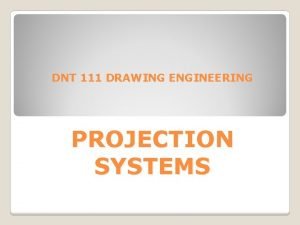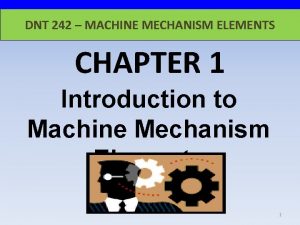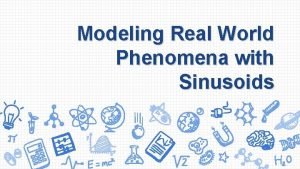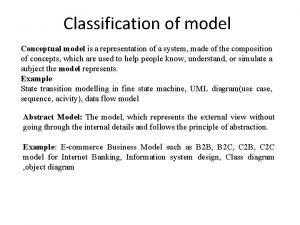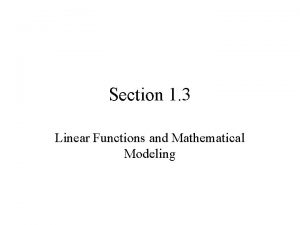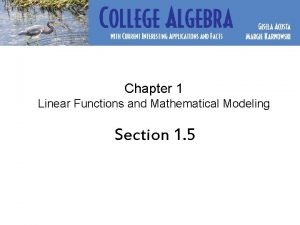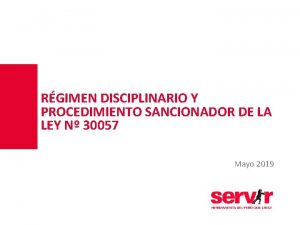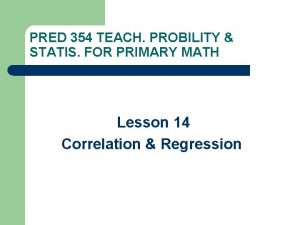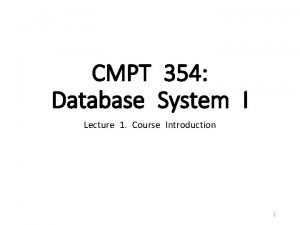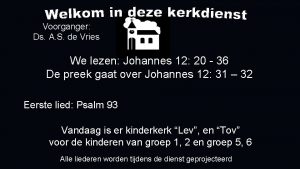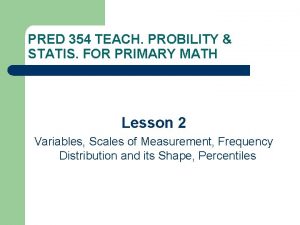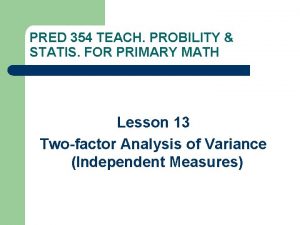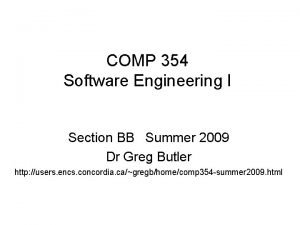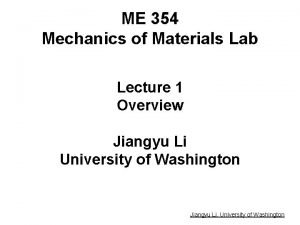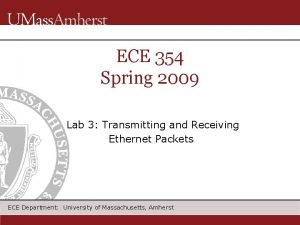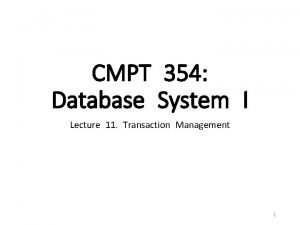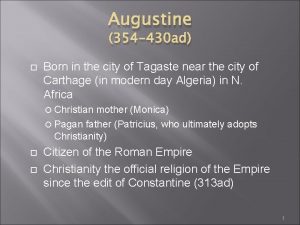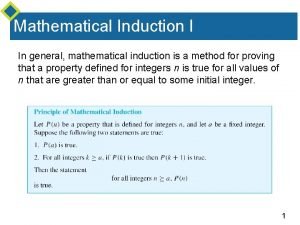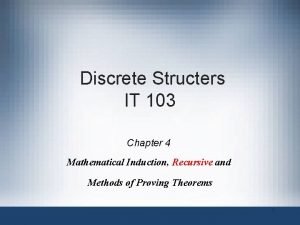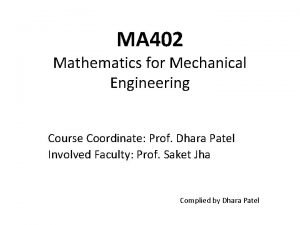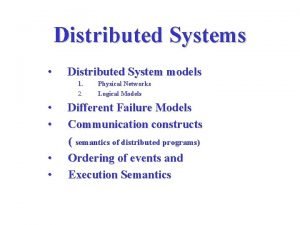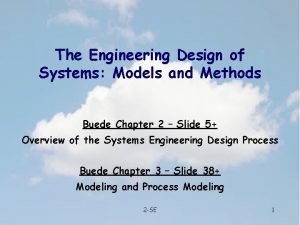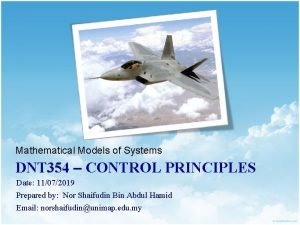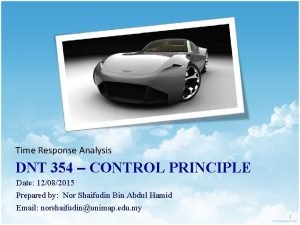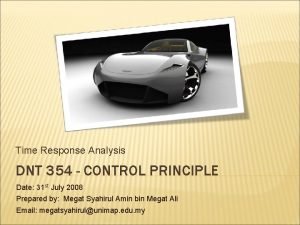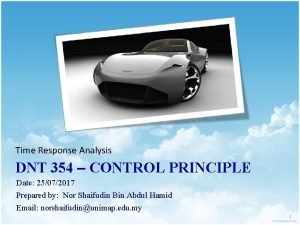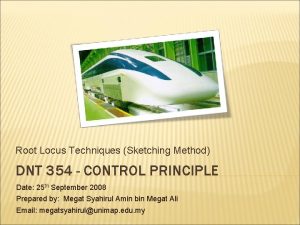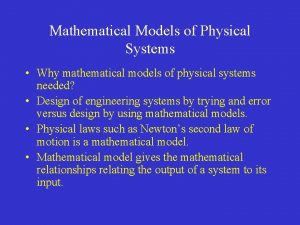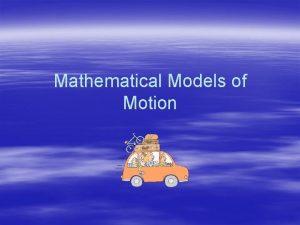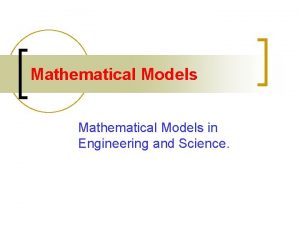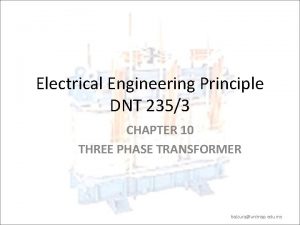Mathematical Models of Systems DNT 354 CONTROL PRINCIPLE







































- Slides: 39

Mathematical Models of Systems DNT 354 – CONTROL PRINCIPLE Date: 17/06/2015 Prepared by: Nor Shaifudin Bin Abdul Hamid Email: norshaifudin@unimap. edu. my

CONTENTS Introduction Differential Equations of Physical Systems The Laplace Transform Transfer Function of Linear Systems Block Diagram

INTRODUCTIONS A mathematical model is a set of equations (usually differential equations) that represents the dynamics of systems. In practice, the complexity of the system requires some assumptions in the determination model. The equations of the mathematical model may be solved using mathematical tools such as the Laplace Transform. Before solving the equations, we usually need to linearize them.

DIFFERENTIAL EQUATIONS How do we obtain the equations? Physical law of the process Differential Equation Examples: i. ii. Mechanical system (Newton’s laws) Electrical system (Kirchhoff’s laws)

DIFFERENTIAL EQUATIONS Example: Springer-mass-damper system The time function of r(t) sometimes called forcing function Assumption: Wall friction is a viscous force. Linearly proportional to the velocity

DIFFERENTIAL EQUATIONS Example: Springer-mass-damper system (cont. ) Newton’s 2 nd Law:

DIFFERENTIAL EQUATIONS Example: RLC Circuit

THE LAPLACE TRANSFORM The differential equations are transformed into algebraic equations, which are easier to solve. The Laplace transformation for a function of time, f(t) is: If, Similarly, Thus, , then,

THE LAPLACE TRANSFORM Example: Spring-mass-damper dynamic equation Laplace Transform for the equation above: When r(t)=0, y(0)= y 0 and (0)=0:

THE LAPLACE TRANSFORM Example: Spring-mass-damper dynamic equation Some Definitions i. q(s) = 0 is called characteristic equation (C. E. ) because the roots of this equation determine the character of the time response. ii. The roots of C. E are also called the poles of the system. iii. The roots of numerator polynomial p(s) are called the zeros of the system.

THE LAPLACE TRANSFORM Transform table: f(t) F(s) 1. δ(t) 1 2. u(t) Step function 3. t u(t) Ramp function 4. tn u(t) 5. e-at u(t) 6. sin t u(t) 7. cos t u(t) Impulse function

THE LAPLACE TRANSFORM Transform Properties

THE LAPLACE TRANSFORM Example: Find the Laplace Transform for the following. i. Unit function: ii. Ramp function: iii. Step function:

THE LAPLACE TRANSFORM Transform Theorem i. Differentiation Theorem ii. Integration Theorem: iii. Initial Value Theorem: iv. Final Value Theorem:

THE LAPLACE TRANSFORM The inverse Laplace Transform can be obtained using: Partial fraction method can be used to find the inverse Laplace Transform of a complicated function. We can convert the function to a sum of simpler terms for which we know the inverse Laplace Transform.

THE LAPLACE TRANSFORM We will consider three cases and show that F(s) can be expanded into partial fraction: i. Case 1: Roots of denominator A(s) are real and distinct. ii. Case 2: Roots of denominator A(s) are real and repeated. iii. Case 3: Roots of denominator A(s) are complex conjugate.

THE LAPLACE TRANSFORM Case 1: Roots of denominator A(s) are real and distinct. Example: Solution: It is found that: A = 2 and B = -2

THE LAPLACE TRANSFORM Case 1: Roots of denominator A(s) are real and distinct. Problem: Find the Inverse Laplace Transform for the following.

THE LAPLACE TRANSFORM Case 2: Roots of denominator A(s) are real and repeated. Example: Solution: It is found that: A = 2, B = -2 and C = -2

THE LAPLACE TRANSFORM Case 3: Roots of denominator A(s) are complex conjugate. Example: Solution: It is found that: A = 3/5, B = -3/5 and C = -6/5

THE LAPLACE TRANSFORM Case 3: Roots of denominator A(s) are complex conjugate. Example: Solution:

THE LAPLACE TRANSFORM Problem: Find the solution x(t) for the following differential equations. i. ii.

THE TRANSFER FUNCTION The transfer function of a linear system is the ratio of the Laplace Transform of the output to the Laplace Transform of the input variable. Consider a spring-mass-damper dynamic equation with initial zero condition.

THE TRANSFER FUNCTION R(s) Y(s) The transfer function is given by the following.

THE TRANSFER FUNCTION Electrical Network Transfer Function Component V-I I-V V-Q Impedance Admittance

THE TRANSFER FUNCTION Problem: Obtain the transfer function for the following RC network.

THE TRANSFER FUNCTION Problem: Obtain the transfer function for the following RLC network. Answer:

THE TRANSFER FUNCTION Op-Amp Circuit Transfer Function § Frequently used to amplify signal in sensor circuits. § § e 1 and e 2 are relative to ground. e 1 to the -ve terminal of the amplifier is inverted, and e 2 to the +ve terminal. The total input to the amplifier is e 2 -e 1. So, we have: The operating conditions for ideal op-amp: i. ii. i 1 = i 2 = 0 (∞ input impedance) e 1 = e 2

THE TRANSFER FUNCTION Inverting Amplifier § Assuming ideal condition, The transfer function for the circuit above is obtained as: Problem: Find the transfer function for a non-inverting amplifier.

THE TRANSFER FUNCTION Mechanical System Transfer Function § The external force u(t) is the input to the system, and the displacement y(t) of the mass is the output. § The displacement y(t) is measured from the equilibrium position. § The transfer function of the system. Problem: Find the transfer function for the mechanical system below.

BLOCK DIAGRAM A block diagram of a system is a practical representation of the functions performed by each component and of the flow of signals. Input Transfer Function G(s) Cascaded sub-systems: Output

BLOCK DIAGRAM Feedback Control System

BLOCK DIAGRAM Feedback Control System The negative feedback of the control system is given by: Ea(s) = R(s) – H(s)Y(s) = G(s)Ea(s) Therefore,

BLOCK DIAGRAM Reduction Rules

BLOCK DIAGRAM Reduction Rules

BLOCK DIAGRAM Problem:

BLOCK DIAGRAM Problem:

FURTHER READING… Chapter 2 i. ii. Dorf R. C. , Bishop R. H. (2001). Modern Control Systems (9 th Ed), Prentice Hall. Nise N. S. (2004). Control System Engineering (4 th Ed), John Wiley & Sons.

“The whole of science is nothing more than a refinement of everyday thinking…” THE END…
 Dnt frivillig arbeid
Dnt frivillig arbeid Projection
Projection Dnt machine
Dnt machine Dnt travsport
Dnt travsport Dnt computer
Dnt computer Econ213
Econ213 Mathematical models for impact prediction
Mathematical models for impact prediction Modeling with sinusoidal functions
Modeling with sinusoidal functions Conceptual physical and mathematical models are used to
Conceptual physical and mathematical models are used to Linear functions as mathematical models
Linear functions as mathematical models Linear functions as mathematical models
Linear functions as mathematical models Types of mathematical models
Types of mathematical models Informe técnico 430-2017-servir-gpgsc
Informe técnico 430-2017-servir-gpgsc Informe técnico nº 1819-2018-servir-gpgsc
Informe técnico nº 1819-2018-servir-gpgsc Time bound promotion for doctors in tamilnadu
Time bound promotion for doctors in tamilnadu Pred-354
Pred-354 Glorie aan god
Glorie aan god Cmpt 733 github
Cmpt 733 github Opwekking 354
Opwekking 354 430
430 Pred354
Pred354 Math pred
Math pred Comp 354
Comp 354 Art 354 kc
Art 354 kc Me 354
Me 354 Cmpt 354
Cmpt 354 Ece 354
Ece 354 Cmpt 354
Cmpt 354 Augustine 354-430 ad
Augustine 354-430 ad What is the difference between modals and semi modals?
What is the difference between modals and semi modals? Geometric sequence closed form
Geometric sequence closed form Principle of mathematical induction
Principle of mathematical induction Inductie matematica
Inductie matematica Mathematical modelling of mechanical systems
Mathematical modelling of mechanical systems How to calculate tarrifs
How to calculate tarrifs Vibration engineering
Vibration engineering Systems and system models
Systems and system models Fundamental models in distributed systems
Fundamental models in distributed systems System models in distributed systems
System models in distributed systems The engineering design of systems: models and methods
The engineering design of systems: models and methods

